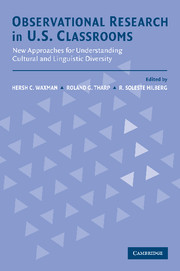 Observational Research in U.S. Classrooms
Observational Research in U.S. Classrooms Book contents
- Frontmatter
- Contents
- Tables, Figures, and Appendixes
- Contributors
- 1 Introduction: Purposes and Perspectives on Classroom Observation Research
- 2 Using Multiple Perspectives in Observations of Diverse Classrooms: The Sheltered Instruction Observation Protocol (SIPO)
- 3 The Standards Performance Continuum: A Performance-Based Measure of the Standards for Effective Pedagogy
- 4 The Uses of the Classroom Observation Schedule to Improve Classroom Instruction
- 5 Development and Use of a Classroom Observation Instrument to Investigate Teaching for Meaning in Diverse Classrooms
- 6 Patterns of Language Arts Instructional Activity and Excellence in First– and Fourth–Grade Culturally and Linguistically Diverse Classrooms
- 7 Using Classroom Observation as a Research and Formative Evaluation Tool in Educational Reform: The School Observation Measure
- 8 Observing School Restructuring in Multilingual, Multicultural Classrooms: Balancing Ethnographic and Evaluative Approaches
- 9 Sociocultural Activity Settings in the Classroom: A Study of a Classroom Observation System
- 10 The Influence of School Reform on Classroom Instruction in Diverse Schools: Findings from an Observational Study of Success for All
- 11 Future Directions for Classroom Observation Research
- Index
- References
6 - Patterns of Language Arts Instructional Activity and Excellence in First– and Fourth–Grade Culturally and Linguistically Diverse Classrooms
Published online by Cambridge University Press: 23 November 2009
- Frontmatter
- Contents
- Tables, Figures, and Appendixes
- Contributors
- 1 Introduction: Purposes and Perspectives on Classroom Observation Research
- 2 Using Multiple Perspectives in Observations of Diverse Classrooms: The Sheltered Instruction Observation Protocol (SIPO)
- 3 The Standards Performance Continuum: A Performance-Based Measure of the Standards for Effective Pedagogy
- 4 The Uses of the Classroom Observation Schedule to Improve Classroom Instruction
- 5 Development and Use of a Classroom Observation Instrument to Investigate Teaching for Meaning in Diverse Classrooms
- 6 Patterns of Language Arts Instructional Activity and Excellence in First– and Fourth–Grade Culturally and Linguistically Diverse Classrooms
- 7 Using Classroom Observation as a Research and Formative Evaluation Tool in Educational Reform: The School Observation Measure
- 8 Observing School Restructuring in Multilingual, Multicultural Classrooms: Balancing Ethnographic and Evaluative Approaches
- 9 Sociocultural Activity Settings in the Classroom: A Study of a Classroom Observation System
- 10 The Influence of School Reform on Classroom Instruction in Diverse Schools: Findings from an Observational Study of Success for All
- 11 Future Directions for Classroom Observation Research
- Index
- References
Summary
In this chapter, I test the utility of using a recently developed live observation tool, the Activity Setting Observation System (ASOS), to quantify and analyze patterns of instructional activity using a sociocultural lens. Specifically, I used the ASOS to examine the extent to which features of effective pedagogical and organizational practices were present in language arts instructional activity in 27 culturally and linguistically diverse first- and fourth-grade classrooms. In addition, I examined the association of the presence of these features with measures of student performance.
Efforts to identify best practices for culturally and linguistically diverse students from poverty backgrounds have grown steadily in recent years. Spurred by the well-known facts of underachievement among this group and its quickly increasing numbers, a number of researchers have begun to document the kinds of classroom instruction these students typically receive, as well as to investigate the kind of instruction that is effective (e.g., Brookhart & Rusnak, 1993; Estrada & Imhoff, 2001a; Garcia, 1990; Saunders & Goldenberg, 1999; Speidel, 1987; Tharp & Gallimore, 1988; Waxman, Huang, & Padrón, 1995).
Ironically, the teaching that these children receive is often an impoverished version of the common tradition dominated by whole-group instruction, teacher talk, assignment of tasks, and assessment. Studies looking at instructional practices in classrooms serving high proportions of low-income students have shown that teachers often operate with a hierarchical or linear perspective of student learning: Basic skills must be mastered before students can engage in higher-order thinking.
- Type
- Chapter
- Information
- Observational Research in U.S. ClassroomsNew Approaches for Understanding Cultural and Linguistic Diversity, pp. 122 - 143Publisher: Cambridge University PressPrint publication year: 2004
References
- 7
- Cited by


